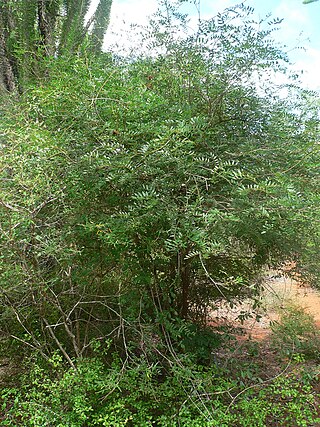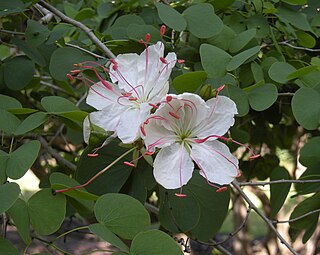
Cordyla is a genus of flowering plants in the family Fabaceae.

Gigasiphon is a genus of plants in the family Fabaceae. The genus is circumscribed is defined by "a long-tubular hypanthium, an arborescent habit, and a calyx divided into two lobes."
Neoharmsia is a genus of legume in the family Fabaceae.
Phylloxylon is a genus of flowering plants in the Indigofereae tribe of the family Fabaceae. There are seven species, all endemic to Madagascar.
Sakoanala is a genus of legume in the family Fabaceae. It contains two species which are endemic to Madagascar.

Adenolobus is a genus of African flowering plants in the legume family, Fabaceae. It belongs to the subfamily Cercidoideae.

Barklya is a genus of Australian trees in the legume family, Fabaceae. It belongs to the subfamily Cercidoideae. The sole species is Barklya syringifolia, commonly known as golden crown or golden glory. It grows in rainforest to 20 metres tall. Recorded from Queensland and New South Wales in rain forest. It is often used as an ornamental.

Griffonia is a genus of central African flowering plants in the legume family, Fabaceae. It belongs to the subfamily Cercidoideae. Griffonia is known to have a high concentration of 5-HTP in its seeds.

Lysiphyllum is a genus of flowering plants in the legume family, subfamily Cercidoideae and tribe Bauhinieae. It belongs to the subfamily Cercidoideae. It was formerly treated as part of the genus Bauhinia, but recent molecular phylogenetic analysis confirms that Lysiphyllum is a distinct genus from Bauhinia.

Piliostigma is a genus of flowering plants in the legume family, Fabaceae. It belongs to the subfamily Cercidoideae and the tribe Bauhinieae. It is dioecious, with male and female flowers on separate plants.

Calicotome is a genus of flowering plants in the family Fabaceae. It belongs to the subfamily Faboideae. It may be synonymous with Cytisus. All species of the genus are thorny shrubs. The ancient Greeks believed that tyrants in Hades were punished by being beaten with the thorny calycotomes.
Clathrotropis is a genus of flowering plants in the family Fabaceae. It belongs to the subfamily Faboideae.
Disynstemon paullinioides is a species of flowering plants in the family Fabaceae. It belongs to the subfamily Faboideae. It is a liana that is native to Madagascar. It is the only member of the genus Disynstemon.

Eysenhardtia is a genus of flowering plants in the family Fabaceae. It belongs to the subfamily Faboideae. Members of the genus are commonly known as kidneywoods.

Hesperolaburnum platycarpum is a species of flowering plants in the family Fabaceae. It belongs to the subfamily Faboideae. It is the only member of the genus Hesperolaburnum.

Hypocalyptus is a genus of flowering plants in the legume family, Fabaceae. It belongs to the subfamily Faboideae and is the only genus found in tribe Hypocalypteae.
Petaladenium urceoliferum is a species of flowering plant in the family Fabaceae. It belongs to the subfamily Faboideae. It is the only member of the genus Petaladenium. It produces three chemical compounds in its leaves that are not found in other members of the Amburaneae: (2S,4S,5R)-5-hydroxy-4-methoxypipecolic acid, (2S,4R,5S)-5-hydroxy-4-methoxypipecolic acid, and (2S,4R,5R)-4-hydroxy-5-methoxypipecolic acid. Petaladenium urceoliferum is unique among legumes in having fimbriate–glandular wing petals.
Platycelyphium voense is a species of flowering plant in the family Fabaceae. It belongs to the subfamily Faboideae. It is the only member of the genus Platycelyphium.
Spirotropis is a genus of flowering plants in the family Fabaceae. It belongs to the subfamily Faboideae.
Lasiobema was a genus of flowering plants in the legume family, Fabaceae, most of which are lianas, belonging to the subfamily Cercidoideae. It was recently (2010) synonymized with Phanera on the basis of morphology, although this was questioned and it can be treated as a section of this genus.










